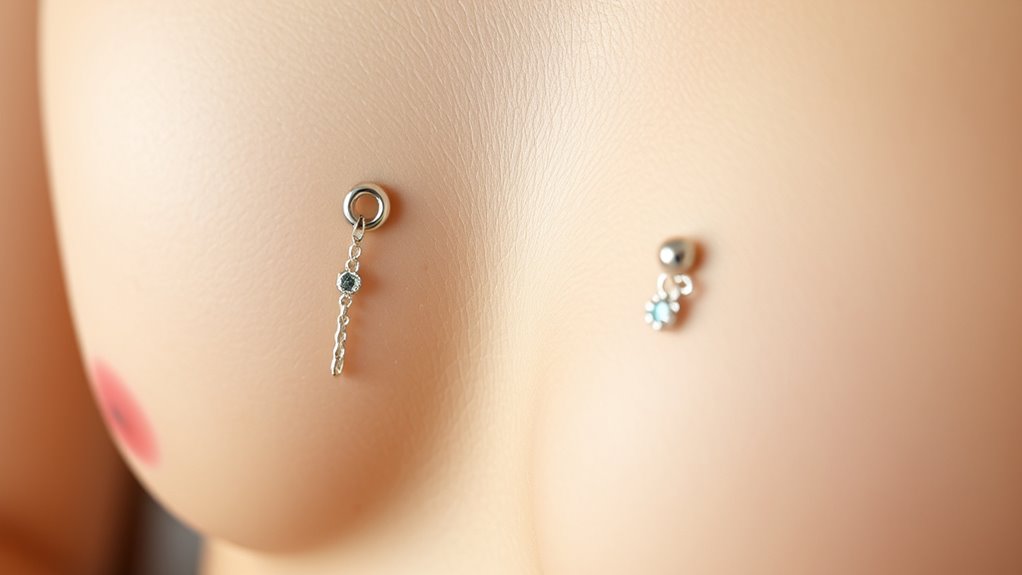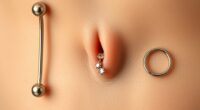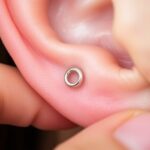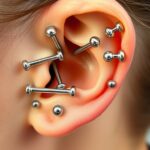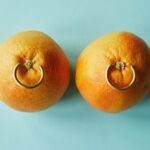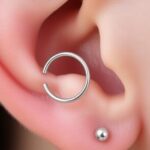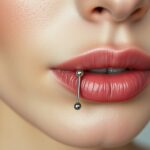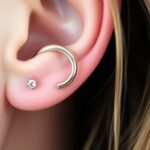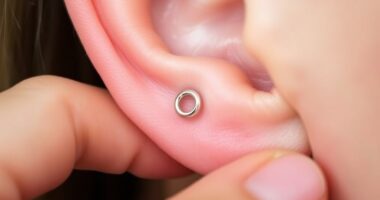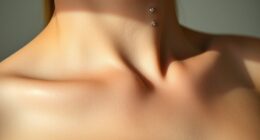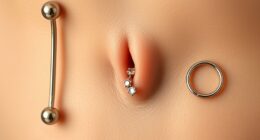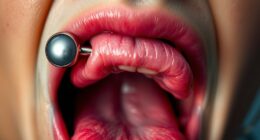When considering nipple piercings, prioritize safety by choosing a professional piercer and high-quality, hypoallergenic jewelry like surgical steel or titanium. During healing, avoid touching or twisting the jewelry, and follow proper aftercare to reduce infection risk and promote healing times of several months to a year. The sensations vary; some find them exciting, while others experience discomfort initially. To discover more about how to safely enjoy nipple piercings and select ideal jewelry, keep exploring the details ahead.
Key Takeaways
- Proper aftercare, including saline cleaning, minimizes infection risk and promotes safe healing of nipple piercings.
- Initial jewelry made from hypoallergenic materials prevents allergic reactions and skin irritation during healing.
- Healing time varies from several months to a year; patience and consistent care are essential for safe healing.
- Post-healing, decorative jewelry enhances personal style; wait until fully healed before switching jewelry types.
- Rushing healing or neglecting aftercare can cause complications like scarring, rejection, or irritation.

Have you ever considered getting a nipple piercing? It’s a bold choice that can enhance your confidence and express your individuality. But before you take the plunge, it’s crucial to understand what’s involved, especially when it comes to the healing process and jewelry options. The healing process varies from person to person but typically takes anywhere from several months up to a year. During this time, your body works to heal the pierced tissue, and you’ll need to be diligent about caring for your new jewelry to prevent infection or irritation. You’ll want to avoid touching or twisting the jewelry unnecessarily, and you should steer clear of swimming pools or hot tubs that could harbor bacteria. Proper aftercare, including gentle cleaning with saline solutions, helps speed up healing and reduces discomfort. Patience is key—rushing the healing process can lead to complications like scarring or rejection. Additionally, understanding the importance of informed aftercare practices can significantly influence your healing success.
When it comes to jewelry options for a nipple piercing, you have a range of choices, but not all are suitable during the initial healing phase. Typically, your piercer will recommend starting with jewelry made from hypoallergenic materials like surgical steel, titanium, or implant-grade silicone. These options are less likely to cause allergic reactions and are easier on your skin during healing. After the initial healing period, you can explore other styles such as captive bead rings, barbells, or even decorative jewelry with gemstones, depending on your personal style. The shape and size of the jewelry are important to prevent snagging or irritation, so consulting with your piercer about the best options for your anatomy is essential. Remember, the jewelry you choose should allow for swelling and be secure enough to stay in place without causing discomfort. Once healed, you can switch to more decorative or personalized pieces, but it’s best to wait until your piercing is fully healed before making any changes.
Getting a nipple piercing is an investment in your body and self-expression, but it requires patience, proper aftercare, and the right jewelry choices. Being aware of the healing process helps you set realistic expectations, while understanding your jewelry options ensures you select pieces that support healing and suit your style. Keep in mind that every body is different, so listen to yours and follow your piercer’s advice closely. With time, care, and the right jewelry, your nipple piercing can become a lasting and empowering part of your personal aesthetic.
Frequently Asked Questions
How Long Does Nipple Piercing Healing Typically Take?
Your nipple piercing healing typically takes about 6 to 12 months. During this time, you should follow proper piercing aftercare to promote healing and prevent infections. The healing duration varies based on individual factors like skin type and aftercare practices. Be patient and consistent with cleaning, avoid irritating activities, and consult your piercer if you notice unusual symptoms. Proper care helps make certain a smooth healing process and long-term satisfaction.
Are There Specific Jewelry Materials Safest for Sensitive Skin?
Yes, for sensitive skin, you should choose jewelry made from hypoallergenic metals like surgical steel, titanium, or niobium. These materials minimize irritation and reduce allergic reactions, especially if you have skin sensitivity. Avoid nickel or cheap alloys, as they can cause discomfort or inflammation. Always opt for high-quality, medical-grade jewelry to guarantee safety and comfort during your healing process.
Can Nipple Piercings Be Performed During Pregnancy?
While pregnancy safety takes priority, you shouldn’t get nipple piercings during pregnancy. Piercing timing is vital, as the body changes and becomes more sensitive, increasing infection risks. Performing piercings now could cause complications or discomfort for you and your baby. It’s best to wait until after pregnancy and breastfeeding to guarantee proper healing and avoid unnecessary health concerns. Prioritize your health and consult your healthcare provider for personalized advice.
What Are the Signs of an Infected Nipple Piercing?
If your nipple piercing shows signs of infection, you’ll notice increased redness, swelling, pain, or warmth around the area. Pus or unusual discharge, a foul smell, or persistent tenderness also indicate infection. Proper aftercare is essential to prevent this; clean the piercing regularly with saline solution, avoid touching it with dirty hands, and steer clear of irritating products. If symptoms worsen, see a healthcare professional promptly.
How Can I Minimize Scarring After Removal?
Sure, because nobody wants a souvenir scar, right? To minimize scarring after removal, focus on scar prevention by keeping the area moisturized with silicone gel or sheets, and protect it from sun exposure. If a scar forms, scar treatment options like massage, silicone, or dermatologist-recommended treatments can help fade it. Patience is key—your skin needs time to heal and blend back into its natural beauty.
Conclusion
Now that you know the ins and outs of nipple piercings, you’re better equipped to make a confident decision. Remember, choosing a professional piercer and proper jewelry is like planting a sturdy seed—your piercing will flourish with care. While sensation varies, understanding safety and jewelry options helps you enjoy your piercing experience without surprises. With patience and proper aftercare, your piercing can be as beautiful and resilient as a well-tended garden—blooming into something uniquely yours.
Piecing together a life one day at a time, that’s me. I’m Rusty, and I love being editor-in-chief of creative piercing. It’s my passion to help others see their vision and bring it to life. When I’m not working or taking care of my family, you can find me reading a good book or eating pie (of course!).

